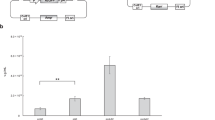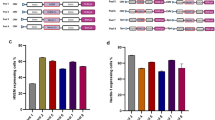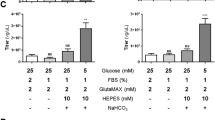Abstract
The interaction between viral capsid proteins and specific molecules exposed on the plasma membrane of the cells is involved in the viral tropism. A human adenovirus (Ad) belonging to subgroups A, C, D, E and F infects cells via the interaction between the fiber knob and the primary receptor, the coxsackievirus and adenovirus receptor (CAR). Conventional human adenovirus type 5 (hAd5) vectors show efficient transduction in CAR-positive cells; in contrast, hAd5 vector application is limited by poor transduction into cells lacking CAR expression. In the present study, to broaden the tropism of hAd5 vectors, we generated hAd5 vectors containing the TAT peptide, which is a protein transduction domain derived from human immunodeficiency virus, in the HI loop of the fiber knob (Ad-TAT(HI)-L2) or the C-terminus of the fiber knob (Ad-TAT(C)-L2). In CAR-negative adherent cells, Ad-TAT(HI)-L2 and Ad-TAT(C)-L2 showed approximately 50- to 500-fold higher gene expression than the conventional hAd5 vector (Ad-L2). Ad-TAT(HI)-L2 was also more efficient than Ad-L2 in blood cell lines and in two types of primary cultured human vascular smooth muscle cells, which are almost refractory to Ad-L2. Furthermore, Ad-TAT(HI)-L2 was more efficient than other types of fiber-modified Ad vectors, which harbor an RGD (Arg-Gly-Asp) or a poly-lysine (KKKKKKK;K7) peptide in the HI loop or the C-terminus of the fiber knob, respectively. Ad-TAT(HI)-L2 efficiently transduced the organs in levels and patterns that were roughly similar to those of Ad-L2 after being systemically injected into mice. To the best of our knowledge, this study is the first report showing that hAd5 vectors containing the TAT peptide in the fiber knob could efficiently transduce cells independently of CAR. These Ad vectors should be useful for gene functional analysis and gene therapy.
This is a preview of subscription content, access via your institution
Access options
Subscribe to this journal
Receive 12 print issues and online access
$259.00 per year
only $21.58 per issue
Buy this article
- Purchase on Springer Link
- Instant access to full article PDF
Prices may be subject to local taxes which are calculated during checkout




Similar content being viewed by others
References
Kovesdi I, Brough DE, Bruder JT, Wickham TJ . Adenoviral vectors for gene transfer. Curr Opin Biotechnol 1997; 8: 583–589.
Benihoud K, Yeh P, Perricaudet M . Adenovirus vectors for gene delivery. Curr Opin Biotechnol 1999; 10: 440–447.
Wickham TJ . Targeting adenovirus. Gene Ther 2000; 7: 110–114.
Mizuguchi H, Hayakawa T . Targeted adenovirus vectors. Hum Gene Ther 2004; 15: 1034–1044.
van Tuyn J, Atsma DE, Winter EM, van der Velde-van Dijke I, Pijnappels DA, Bax NA et al. Epicardial cells of human adults can undergo an epithelial-to-mesenchymal transition and obtain characteristics of smooth muscle cells in vitro. Stem Cells 2007; 25: 271–278.
Wickham TJ, Tzeng E, Shears II LL, Roelvink PW, Li Y, Lee GM et al. Increased in vitro and in vivo gene transfer by adenovirus vectors containing chimeric fiber proteins. J Virol 1997; 71: 8221–8229.
Dmitriev I, Krasnykh V, Miller CR, Wang M, Kashentseva E, Mikheeva G et al. An adenovirus vector with genetically modified fibers demonstrates expanded tropism via utilization of a coxsackievirus and adenovirus receptor-independent cell entry mechanism. J Virol 1998; 72: 9706–9713.
Vigne E, Mahfouz I, Dedieu JF, Brie A, Perricaudet M, Yeh P . RGD inclusion in the hexon monomer provides adenovirus type 5-based vectors with a fiber knob-independent pathway for infection. J Virol 1999; 73: 5156–5161.
Koizumi N, Mizuguchi H, Hosono T, Ishii-Watabe A, Uchida E, Utoguchi N et al. Efficient gene transfer by fiber-mutant adenoviral vectors containing RGD peptide. Biochim Biophys Acta 2001; 1568: 13–20.
Mizuguchi H, Koizumi N, Hosono T, Utoguchi N, Watanabe Y, Kay MA et al. A simplified system for constructing recombinant adenoviral vectors containing heterologous peptides in the HI loop of their fiber knob. Gene Therapy 2001; 8: 730–735.
Dmitriev IP, Kashentseva EA, Curiel DT . Engineering of adenovirus vectors containing heterologous peptide sequences in the C terminus of capsid protein IX. J Virol 2002; 76: 6893–6899.
Koizumi N, Mizuguchi H, Utoguchi N, Watanabe Y, Hayakawa T . Generation of fiber-modified adenovirus vectors containing heterologous peptides in both the HI loop and C terminus of the fiber knob. J Gene Med 2003; 5: 267–276.
Vellinga J, Rabelink MJ, Cramer SJ, van den Wollenberg DJ, Van der Meulen H, Leppard KN et al. Spacers increase the accessibility of peptide ligands linked to the carboxyl terminus of adenovirus minor capsid protein IX. J Virol 2004; 78: 3470–3479.
Kurachi S, Koizumi N, Sakurai F, Kawabata K, Sakurai H, Nakagawa S et al. Characterization of capsid-modified adenovirus vectors containing heterologous peptides in the fiber knob, protein IX, or hexon. Gene Therapy 2007; 14: 266–274.
Gupta B, Levchenko TS, Torchilin VP . Intracellular delivery of large molecules and small particles by cell-penetrating proteins and peptides. Adv Drug Deliv Rev 2005; 57: 637–651.
Mizuguchi H, Kay MA . Efficient construction of a recombinant adenovirus vector by an improved in vitro ligation method. Hum Gene Ther 1998; 9: 2577–2583.
Mizuguchi H, Kay MA . A simple method for constructing E1- and E1/E4-deleted recombinant adenoviral vectors. Hum Gene Ther 1999; 10: 2013–2017.
Arap W, Pasqualini R, Ruoslahti E . Cancer treatment by targeted drug delivery to tumor vasculature in a mouse model. Science 1998; 279: 377–380.
Maizel Jr JV, White DO, Scharff MD . The polypeptides of adenovirus. I. Evidence for multiple protein components in the virion and a comparison of types 2, 7A, and 12. Virology 1968; 36: 115–125.
Shen H, Mai JC, Qiu L, Cao S, Robbins PD, Cheng T . Evaluation of peptide-mediated transduction in human CD34+ cells. Hum Gene Ther 2004; 15: 415–419.
Kawabata K, Sakurai F, Yamaguchi T, Hayakawa T, Mizuguchi H . Efficient gene transfer into mouse embryonic stem cells with adenovirus vectors. Mol Ther 2005; 12: 547–554.
Sakurai F, Kawabata K, Yamaguchi T, Hayakawa T, Mizuguchi H . Optimization of adenovirus serotype 35 vectors for efficient transduction in human hematopoietic progenitors: comparison of promoter activities. Gene Therapy 2005; 12: 1424–1433.
Tyagi M, Rusnati M, Presta M, Giacca M . Internalization of HIV-1 tat requires cell surface heparan sulfate proteoglycans. J Biol Chem 2001; 276: 3254–3261.
Console S, Marty C, Garcia-Echeverria C, Schwendener R, Ballmer-Hofer K . Antennapedia and HIV transactivator of transcription (TAT) ‘protein transduction domains’ promote endocytosis of high molecular weight cargo upon binding to cell surface glycosaminoglycans. J Biol Chem 2003; 278: 35109–35114.
Weeks BS, Desai K, Loewenstein PM, Klotman ME, Klotman PE, Green M et al. Identification of a novel cell attachment domain in the HIV-1 Tat protein and its 90-kDa cell surface binding protein. J Biol Chem 1993; 268: 5279–5284.
Vogel BE, Lee SJ, Hildebrand A, Craig W, Pierschbacher MD, Wong-Staal F et al. A novel integrin specificity exemplified by binding of the alpha v beta 5 integrin to the basic domain of the HIV Tat protein and vitronectin. J Cell Biol 1993; 121: 461–468.
Schwarze SR, Ho A, Vocero-Akbani A, Dowdy SF . In vivo protein transduction: delivery of a biologically active protein into the mouse. Science 1999; 285: 1569–1572.
Gratton JP, Yu J, Griffith JW, Babbitt RW, Scotland RS, Hickey R et al. Cell-permeable peptides improve cellular uptake and therapeutic gene delivery of replication-deficient viruses in cells and in vivo. Nat Med 2003; 9: 357–362.
Kuhnel F, Schulte B, Wirth T, Woller N, Schafers S, Zender L et al. Protein transduction domains fused to virus receptors improve cellular virus uptake and enhance oncolysis by tumor-specific replicating vectors. J Virol 2004; 78: 13743–13754.
Xu ZL, Mizuguchi H, Ishii-Watabe A, Uchida E, Mayumi T, Hayakawa T . Optimization of transcriptional regulatory elements for constructing plasmid vectors. Gene 2001; 272: 149–156.
Acknowledgements
We thank Yuriko Teramura for technical assistance. This work was supported by grants from the Ministry of Health, Labor, and Welfare of Japan.
Author information
Authors and Affiliations
Corresponding author
Rights and permissions
About this article
Cite this article
Kurachi, S., Tashiro, K., Sakurai, F. et al. Fiber-modified adenovirus vectors containing the TAT peptide derived from HIV-1 in the fiber knob have efficient gene transfer activity. Gene Ther 14, 1160–1165 (2007). https://doi.org/10.1038/sj.gt.3302969
Received:
Revised:
Accepted:
Published:
Issue Date:
DOI: https://doi.org/10.1038/sj.gt.3302969
Keywords
This article is cited by
-
HER3 targeting of adenovirus by fiber modification increases infection of breast cancer cells in vitro, but not following intratumoral injection in mice
Cancer Gene Therapy (2012)
-
Branched oligomerization of cell-permeable peptides markedly enhances the transduction efficiency of adenovirus into mesenchymal stem cells
Gene Therapy (2010)



